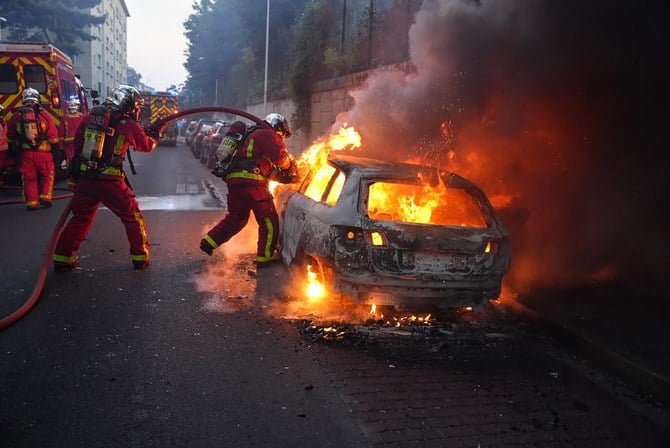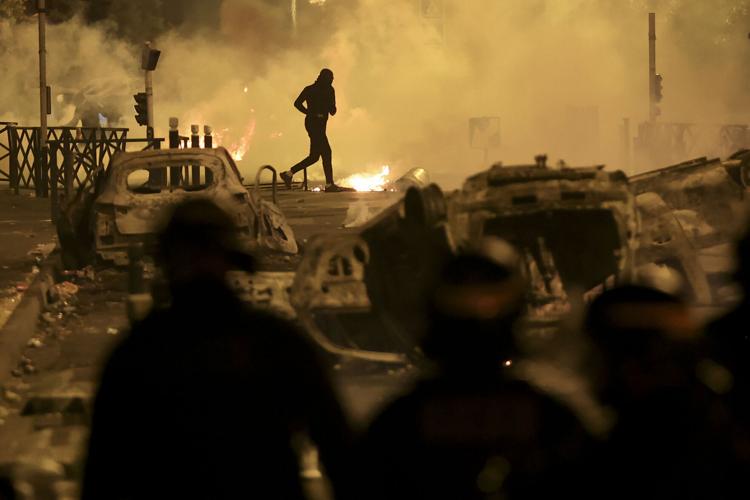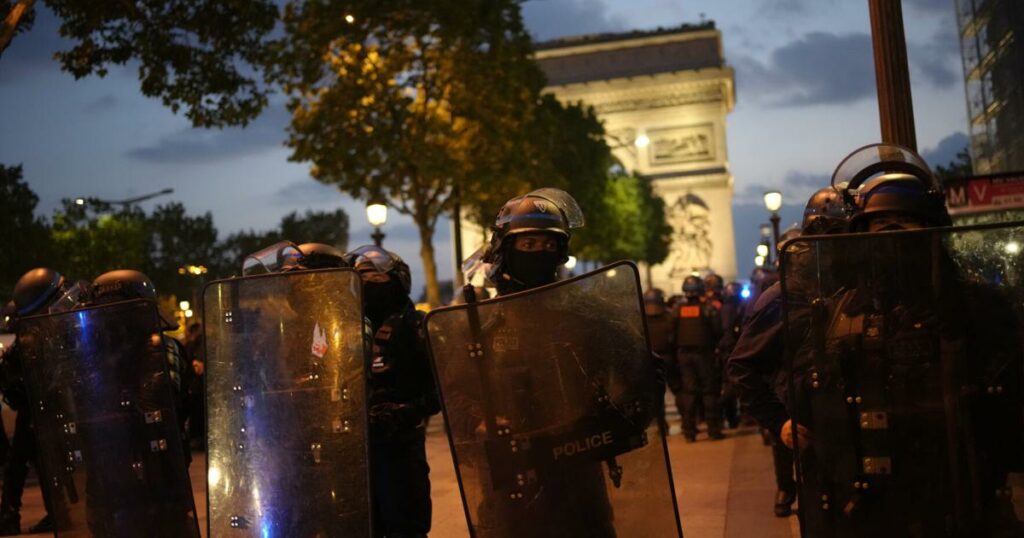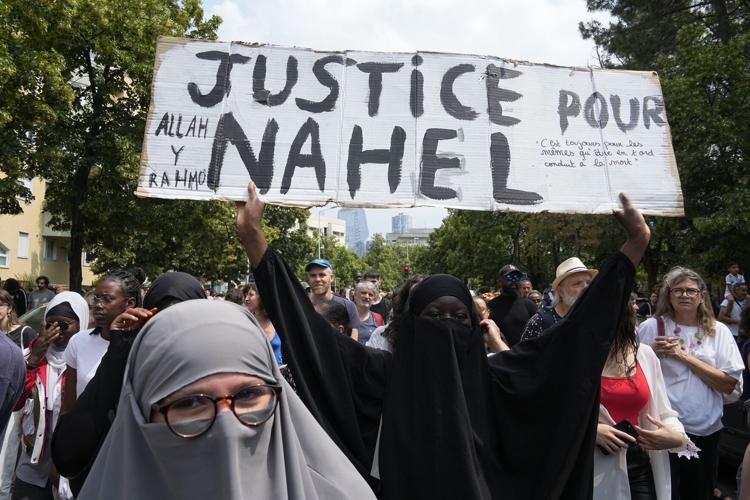On 27 June, the eve of Eid Al-Adha, a 17-year-old in France of Algerian descent was driving through his neighbourhood of Nanterre in a rental car. At 8 AM that day, he was brutally shot and killed by a police officer. He was shot at for violation of traffic rules. This is not the first time that the French law enforcement has come under scrutiny; last year alone thirteen people were killed by the police force for refusing to adhere to traffic regulations. This was a consequence of the revised law in France concerning traffic stops that allows the police to shoot at a vehicle escaping a traffic stop if the vehicle is endangering the lives of its passengers or passerby.
Like with the 2020 protests in the US against the police brutality inflicted against George Floyd, here too the residents of Nanterre took to the streets in protest. The death of Nahel, whose first name alone has been revealed to the public, became a rallying cry for the minority communities of France as protesters across the nation vandalised state institutions.
But then again; this was not an isolated incident of police brutality but a symptom of the larger systemic issue of racism and intolerance that has plagued France as well as most of the world since the time of colonisation.

Like with the 2020 protests in the US against the police brutality inflicted against George Floyd, here too the residents of Nanterre took to the streets in protest. The death of Nahel, whose first name alone has been revealed to the public, became a rallying cry for the minority communities of France as protesters across the nation vandalised state institutions.
Police brutality and its repercussions
When the two police officers responsible for Nahel’s death were questioned, they cited opening fire as a response to their own lives being in danger from the teenagers in the car. However, a surveillance video clearly showcases the two standing near the window, one of them with a gun pointed into the car before the car started moving. This video quickly circulated online and served to amplify the anger of the people and distrust towards the French law enforcement.
What started out as a protest outside police headquarters in the suburbs of Paris’ Nanterre on 27th June soon escalated into large-scale rioting as the protesters set fire to cars and blasted fireworks at the police. A town hall was firebombed in the town of Mantes-la-Jolie, around 40 km from Paris that night. Clashes were reported across Paris and also in the cities of Lille and Toulouse. By 29th June over 150 people had been arrested.
On 29th June, a police officer taken into custody for the shooting was charged with voluntary homicide — a review found that the officer in question did not meet the legal standard while opening fire on Nahel.
What started out as a protest outside police headquarters in the suburbs of Paris’ Nanterre on 27th June soon escalated into large-scale rioting as the protesters set fire to cars and blasted fireworks at the police. A town hall was firebombed in the town of Mantes-la-Jolie, around 40 km from Paris that night. Clashes were reported across Paris and also in the cities of Lille and Toulouse. By 29th June over 150 people had been arrested. On 1st July alone, as many as 1300 people were arrested as France deployed 45,000 police officers in an unsuccessful attempt to curb the violence and protests. Several French cities announced curfews or banned demonstrations in an effort to stagger the rioting and violence.

The chant taken up by the protesters is “Justice pour Nahel”. However, their demands for justice go beyond the death of just one person. Through their demonstrations, the protesters are trying to “open a wider debate about what they see as systemic police abuse, particularly in the working-class suburbs” according to Rebecca Rosman, a reporter for NPR.
Governmental response
When the news broke in France, condolences and support poured in from all corners for Nahel’s family — from the Mayor of Nanterre Patrick Jarry to the imams at the Grand Mosque of Paris. On the day of Nahel’s death, President Emmanuel Macron was reported calling the act ‘inexplicable and unforgivable‘. However, the narrative was flipped on its head by Saturday when rioting and unrest had travelled from Paris to the communities toward the North and the South.
Macron, who had publicly denounced Nahel’s murder before, now called upon the parents of these teen protesters to exercise restraint over their children. He went on to blame video games for having intoxicated the children and thus being a contributing factor to the ongoing riots.
To the surprise of politicians and civilians alike, most of the protesters involved in the rioting were teenagers. Macron, who had publicly denounced Nahel’s murder before, now called upon the parents of these teen protesters to exercise restraint over their children. He went on to blame video games for having intoxicated the children and thus being a contributing factor to the ongoing riots. He also blamed the younger generation’s engagement with social media like TikTok and Snapchat for inciting and organising rioting and even threatened to cut off social media in response to the rioting, which led to accusations of totalitarianism falling on his government.

On 30 June, The United Nations Human Rights Office issued a statement urging France to address its deep-rooted issues of racial discrimination.
Misinformation and its spread
Misinformation about the protests was circulated via social media such as Instagram and Twitter by far-right and anti-migrant users both from within as well as outside France’s borders. Paul Golding who is the leader of a far-right British party shared a video, captioned “Armed rioters show off their arsenal of weapons in France”, that went on to receive millions of views. In fact, the video was taken from another clash that had taken place three years ago. There were other images and videos doing the rounds on platforms like Instagram and TikTok that were either completely false or taken out of context to cast the minority communities protesting in a negative light.
In France too, several anti-immigrant users were quick to take to social media to spread hatred through false images and video clips. There was a video of a Portuguese-speaking woman hastily shopping in a supermarket captioned “What do you want them to tell their kids, they do the same!”, suggesting the mothers of the rioters were thieves. This video was actually taken from a timed challenge in Brazil, the aim of the challenge being to shop as fast as possible.
In France too, several anti-immigrant users were quick to take to social media to spread hatred through false images and video clips. There was a video of a Portuguese-speaking woman hastily shopping in a supermarket captioned “What do you want them to tell their kids, they do the same!”, suggesting the mothers of the rioters were thieves. This video was actually taken from a timed challenge in Brazil, the aim of the challenge being to shop as fast as possible.
Another clip posted on Twitter, shows a group of people breaking into a Louis Vuitton shop. The caption claims that the clip features rioters looting the Louis Vuitton shop in Paris, while in reality it was taken from the time of the protests over George Floyd’s death in America in 2020.

In India, misinformation manifested in the form of several social media users circulating fake images and video clips of ruined buildings, attributing them to the “Muslim rioters” in France. Such pictures and videos were mostly circulated by accounts having a history of Islamophobic and pro-Hindutva comments and posts. For instance, there was a video circulated on Twitter and other platforms that showed cars falling down from the top of a car park, crashing into several cars on the street and exploding from the impact. The caption on the video read, “France elected a secular liberal Macron as president rather than a nationalist woman, see the result”. The clip was actually taken from the filming of the 2017 movie Fast and Furious 8 which took place in Cleveland, Ohio.
This is just one of several instances that have fed into the tidal wave of Islamophobic misinformation in India. There are staged videos online of a Muslim man mixing toilet water with street snacks before being confronted by passerby, of a Muslim fruit seller who gets caught trying to cheat his customers and is assaulted. According to experts, such videos play into existing negative stereotypes about the roughly 210 million Muslims living in India. These posts are freshly circulated during times of communal duress to further flare the tensions between the Hindus and the Muslims.
All of these images and video clips, though shared by different people belonging to different countries, were all united in their aim to spread intolerance and hatred against the migrant, the Muslim community in France.
About the author(s)
Keerthana (she/her) is a third-year English Literature student at St. Stephen’s College, Delhi University. She is interested in analysing art and pop culture through feminist and other sociocultural theories. She enjoys literature, music, films and the occasional cricket match.





